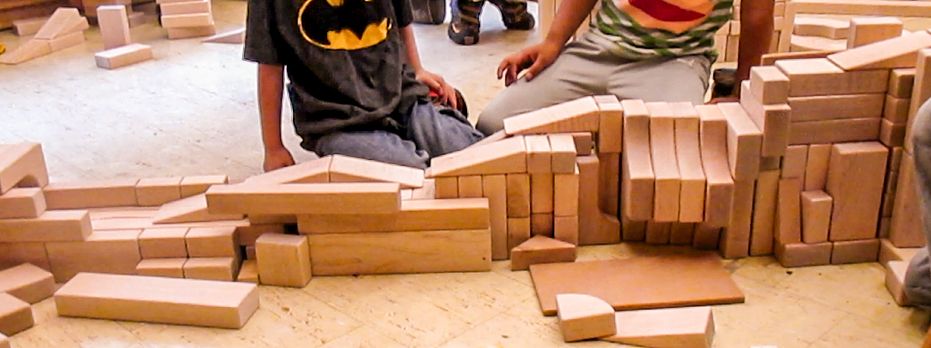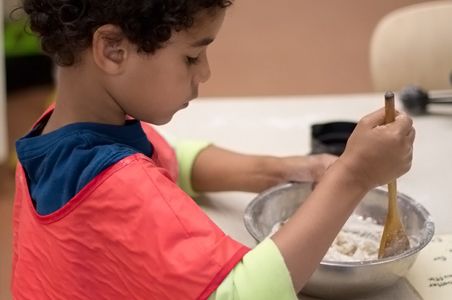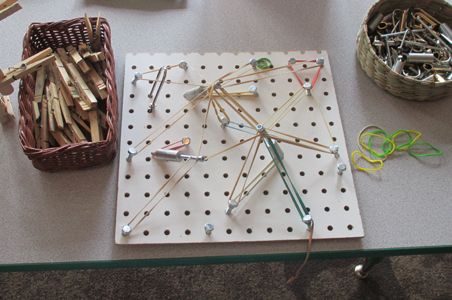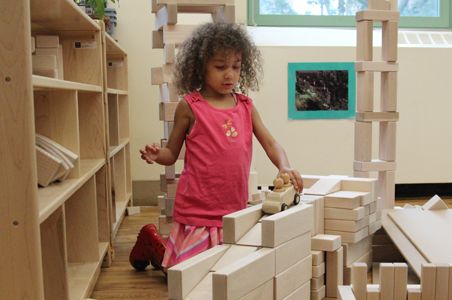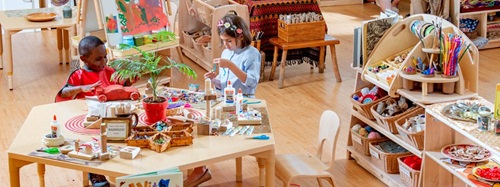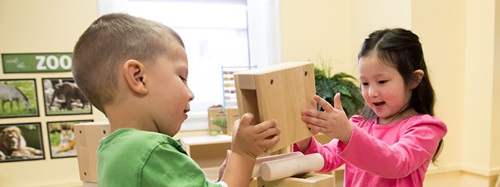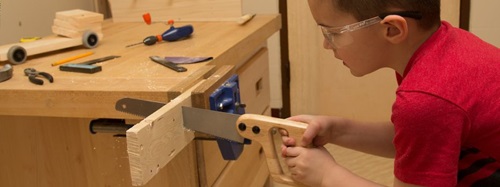Problem Solving:
Engineering Experiences in Early Childhood
|
July 2015
In the unit block center in their Head Start classroom, two children work to build a long bridge. Carefully, they position several rectangle unit blocks on their short ends to support double unit blocks across the tops to create their bridge. The bridge falls down repeatedly. They experiment with turning the units different ways before straddling them with the double unit block, but the bridge continues to fall down. Then they try different blocks as supports for their bridge. When one child tries the large cylinder, they notice that the bridge appears to be more stable. They replace all of their rectangular unit blocks with large cylinders and continue to build and play with their bridge.
The sensory table has been taken outside to the playground and filled with bubble solution. The nearby picnic table has materials for making bubble wands. One child picks up a pipe cleaner and makes a bubble wand shaped like a triangle. She dips it into the bubble solution, blows through it to make a bubble, and stares at bubble. She returns to the table, this time making a bubble wand in the shape of a rectangle. Again she tests her wand, stares at her bubble, and returns to the table. She repeats this process again and again. When her teacher asks her what she is trying to do, she replies that she wants to make a bubble that is not round, but so far, she hasn’t figured out how to do it.
A kindergartener is making a pancake at the cooking center. He is eager to eat the pancake, so he flips the pancake early and moves it to his plate before it browns. It is doughy and does not taste good. He complains to the teacher, who reviews the recipe with him step by step, asking him at each step if he did it as written. He says that he did. She then points out that his pancake was a very pale tan color, whereas other children’s pancakes were darker brown. She encourages him to try again. He makes several more pancakes, each time cooking it a bit longer, until he gets a pancake that he is satisfied with.
Two first graders are working at the ramps center, connecting three segments to create a system for a marble to descend and then travel over a small hill. When they test their ramp structure, the marble flies off at the first connection of two segments. To compensate, the children use unit blocks to build walls alongside the track to keep the marble on the ramp, but the marble bounces off at the last connection. Finally, one child stands at the end of the ramp and eyes it from start to finish, raising her eyebrows. She straightens the connection between the two ramps so that they are in better alignment. Another child then releases the marble, and it travels across the connection. Giggling at their success, they add another section of track and continue to build, test, and adjust their system.
What do these four anecdotes with children ranging in age from three to seven years of age have in common? All of them illustrate how children engage in engineering. A report by the National Academy of Engineering and the Board on Science Education at the Center for Education, Engineering in K-12 Education, defines engineering as “a systematic and often iterative approach to designing objects, processes, and systems to meet human needs and wants” (Council 2009, p 49). Embedded within this iterative approach to the design process is problem solving. The children in each of these anecdotes are highly engaged in solving the problems they encounter as they build and cook. They are thinking of solutions, testing their solutions, revising their solutions, and testing them again until they achieve the results they want. As illustrated in the anecdotes above, the potential for rich engineering experiences already exists in early childhood programs, but educators who do not understand what engineering is do not recognize these opportunities when they occur in their programs.
Children are highly engaged in problem solving when they do every-day activities like cooking.
Engaging children in engineering has many benefits from a curricular standpoint. It allows teachers to integrate all four of the STEM disciplines (science, technology, engineering, and mathematics) in a seamless fashion. The four anecdotes above show children grappling with physics (forces, motion, balance, stability), chemistry (mixing substances to obtain a new substance, applying heat to change substances), mathematics (spatial reasoning, mental rotation of 3-D shapes, volume, number, measurement), and technology (tool use and designing new tools or systems). The processes involved in these activities also have significant benefits in other areas of children’s development.
Perhaps the most significant domain that is strengthened is “Approaches to Learning”. This term refers to how a child responds to new learning situations, and includes curiosity, engagement, initiative, persistence, problem solving, creativity, and inventiveness. These qualities are essential for later learning and affect academic success across all content domains. “Approaches to Learning” is considered a school readiness area by the U.S. Department of Health and Human Services, and is included in the Head Start Child Development and Early Learning Framework (Office of Head Start 2011). Activities which are imbedded with engineering experiences naturally promote these essential school readiness skills.
Loose parts allow children opportunities to "figure it out".
Factors to Consider in Implementing Engineering Experiences
1. Look for places where children are already working to solve problems.
Make solving problems a part of your classroom culture; highlight problems and celebrate solutions. One of our colleagues, Dr. Christina Sales, explained to us that she tried to view every problem in the classroom as an opportunity for learning. Examples of problems that teachers could use include devising a system that will allow every child to have a fair turn at a highly coveted experience, figuring out how to transport water from the sink to the plants on the shelf, repairing a broken toy, or keeping track of when the eggs in the incubator have been turned. All involve brainstorming, evaluating, testing, and revising solutions.
2. Resist the urge to solve children’s problems for them.
Many adults respond almost automatically to young children’s problems. A child need only hold out a foot with an untied shoe, and most adults will bend over and tie the shoe without even thinking. Before responding, teachers should do a quick assessment and determine whether the problem is one that the child might reasonably be able to solve on his or her own or with a small amount of adult support. If so, a better response might be, “I see you have a problem. What are you going to do about that?”
3. Analyze activities for their potential for children to “figure it out”.
The late Dr. Rheta DeVries often challenged teachers to critique children’s activities with the question, “What is there in this activity for children to figure out?” This question helps teachers determine if the activity is a task for children to complete, or an open-ended exploration that allows children to figure out how the world works. When teachers ask themselves this question, they begin to recognize the value of areas of the classroom, previously neglected, because the centers “ran themselves” or were merely opportunities for free play. In reflecting on these centers, the teachers realized that children stayed engaged in the block area because there was so much for them to figure out. Engineering is often the catalyst for rich activity; the opportunity to design, test, and problem-solve is what attracts and keeps children engaged. Activities involving blocks, ramps, water tables, shadow theaters, cooking, bubbles, and the like are examples of activities that offer opportunities for children to engage in engineering.
4. Allow adequate time for children to grapple with problems.
Adequate time refers to time measured in minutes and hours during the day as well as time over days, weeks, and months. Sometimes, it takes children many experiences working with a particular material before they reach the point where they even notice some of the problems. No doubt the child trying to blow bubbles in different shapes had many experiences blowing bubbles before she even noticed that all bubbles are spherical. Other times, the problems are quickly recognized and the child is driven to figure it out but needs time to find solutions. Demanding that children rotate activities after 20 minutes, rather than allowing them to stay and focus on solving a problem, frustrates children, interrupts their concentration and conceptual development, and undermines the development of persistence.
5. Observe closely to guide instructional decisions.
Teachers do their best teaching after close observation of their students working. Observation allows teachers to consider the interaction among the child, the environment, and the teacher. Watching a child work allows a teacher to get a perception of the child’s conceptual understanding and approaches to learning. The usefulness (or distraction) of materials and work space can be observed by how the child is engaging with them. With this information in mind, teachers can make decisions on when to add or take away materials, arrange spaces differently, or intervene with a question or comment to support the child’s design and problem solving.
When given inspiring materials, young engineers emerge!

